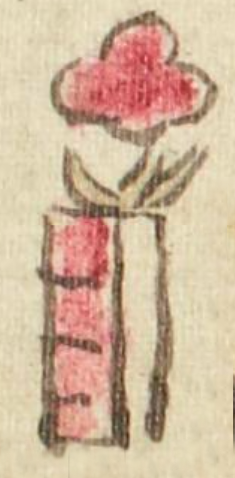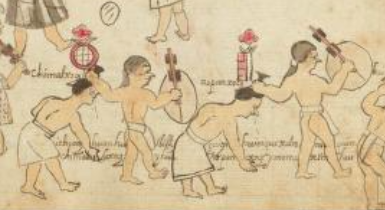Tozpanxoch (Azca16)
This painted black-line drawing of the compound glyph for the personal name (perhaps “Yellow-Headed Parrot Flag-Flower” or “Yellow Flag-Flower”) is attested here as a woman’s name. The contextualizing image shows that the person with the name Tozpanxoch has been taken captive. She wears only a skirt. The warrior who has captured her is holding her by her hair. Her sister Chimalxoch was also taken captive in this scene, as was their father, Huitzilihuitl. The captors were the Xaltocameca.
Stephanie Wood
There is a Tozpan glyph in this collection (as of May 2025), but not another Tozpanxoch.
Stephanie Wood
tospanxoch
Tozpanxoch
Stephanie Wood
post-1550, possibly from the early seventeenth century.
Jeff Haskett-Wood
loros, flores, colores, amarillo, banderas, nombres de mujeres

toz(tli), yellow-headed Amazon parrot, https://nahuatl.wired-humanities.org/content/toztli
xoch(itl), flower, https://nahuatl.wired-humanities.org/content/xochitl
pan(itl), a flag or banner, https://nahuatl.wired-humanities.org/content/panitl
Loro Amarillo-Flor, o Bandera Amarilla-Flor
Stephanie Wood
The Codex Azcatitlan is also known as the Histoire mexicaine, [Manuscrit] Mexicain 59–64. It is housed in the Bibliothèque Nationale de France, and hosted on line by the World Digital Library and the Library of Congress, which is “unaware of any copyright or other restrictions in the World Digital Library Collection.”
https://www.loc.gov/resource/gdcwdl.wdl_15280/?sp=16&st=image
The Library of Congress is “unaware of any copyright or other restrictions in the World Digital Library Collection.” But please cite Bibliothèque Nationale de France and this Visual Lexicon of Aztec Hieroglyphs.




